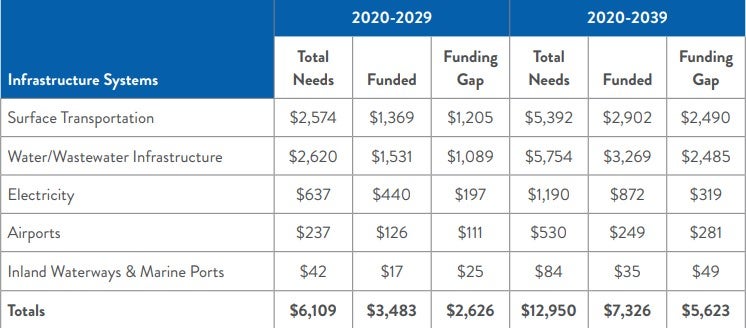Next month before a joint session of Congress, President-elect Joe Biden plans to lay out his Build Back Better recovery plan that he claims will make “historic” investments in infrastructure.
“It’s time to stop talking about infrastructure and finally start building infrastructure,” Biden said while unveiling his $1.9 trillion COVID relief plan Thursday.
“Millions of good-paying jobs putting Americans to work rebuilding our roads, our bridges, our ports to make them more climate resilient, to make them faster, cheaper, cleaner to transport American-made goods across our country and around the world, that’s how we compete. Failure to do so will cost us dearly,” Biden said.
Quantifying costs
The American Society of Civil Engineers (ASCE) recently attempted to quantify that cost. In a report released on Jan. 12 called “Failure to Act: Economic Impacts of Status Quo Investment Across Infrastructure Systems,” ASCE concluded that the investment gap between projected needs and likely investment in critical infrastructure systems is more than $2.6 trillion by 2029 and more than $5.6 trillion by 2039.
“The long-term effects associated with infrastructure investments, long known to be a public safety issue, has a cascading impact on our nation’s economy, impacting business productivity, GDP, employment, personal income and international competitiveness,” the report stated.

Infrastructure needs by system based on current trends, extended to 2029 and 2039 (in $2019 billions).
Source: ASCE, Economic Development Research Group (EBP)
With the outcome of the U.S. Senate elections in Georgia splitting the chamber 50-50 – with incoming Vice President Kamala Harris casting deciding votes on legislation in the case of ties – the Democrats have control in both chambers and the White House.
But whether that trifecta will be enough to get a long-awaited long-term infrastructure package across the finish line is up for debate.
“It’s doable, but the Democrats are not going to be able to reinvent the wheel” by including a lot of provisions not palpable to Republicans, Jeff Davis, a policy expert at the Eno Center for Transportation, told FreightWaves.
Democrats may use the infrastructure bill that the Democrat-controlled House passed last summer as a starting point – a bill that included:
- Raising minimum insurance coverage for commercial trucks from $750,000 to $2 million.
- Making driver Compliance, Safety, Accountability (CSA) scores public.
- Public funding for truck parking.
- Automatic emergency braking requirements.
- Stricter standards for side and rear underride guards
The Mayor Pete Effect
Another advantage for Biden and the prospects for an infrastructure package: He will have U.S. Department of Transportation (DOT) secretary nominee Pete Buttigieg as his “chief salesman/apostle” to help sell the proposal to Congress and at public events, Davis said. “It’s the first time we’ve had someone as DOT secretary coming in with a significant national political following.”
However, Biden’s political edge could be undercut, Davis explained, by the Senate cloture rule, which requires 60 votes to cut off debate on most types of legislation – meaning that senators in the opposition party can filibuster the majority’s agenda.
Davis also pointed out that while some Republicans may want to get a long-term infrastructure bill passed, “they’re not eager to raise taxes to pay for anything,” he said. “And now that all this money has gone out on COVID and the Trump tax cuts, there’s not going to be a big appetite for deficit spending.”
A view from inside
John Delaney, a former U.S. congressman who released his own $2 trillion infrastructure proposal in May 2019 when he was a contender for the Democratic presidential nomination, said there are other structural issues in Congress that need to be addressed.
“One of the first things I worked on when I came to Washington was a big bipartisan infrastructure proposal,” Delaney said Thursday. Delaney, a senior adviser at startup investment firm Revolution, was speaking with Revolution founder Steve Case on startups and the Biden administration.
“Republicans were advocating at the time for fixing our international tax system, which was trapping money overseas and being prevented from flowing back to the United States and preventing us from getting tax revenues from it. I proposed fixing that system to make it more pro business and use the revenues from that to invest in infrastructure – it got huge bipartisan support. But the issue was, to some extent, bipartisan legislation is at a disadvantage in the Congress because the leadership wants to put up partisan wins.”
Business push
One of the most powerful lobbying groups in Washington – the U.S. Chamber of Commerce – has made infrastructure its top legislative priority. The group, which recently launched the “Build by the Fourth of July” campaign to push Congress to get infrastructure legislation done by that date, is optimistic even with a 50-50 Senate and a House chamber that’s separated by only five votes.
“We can also stimulate the economy in a major way if we finally do the long overdue and broadly supported work of rebuilding our infrastructure,” said U.S. Chamber CEO Tom Donohue at his State of American Business address on Jan. 12.
“It’s the number one way to raise productivity, create jobs and drive up incomes in a hurry. Our lawmakers should enact a fiscally and environmentally responsible infrastructure package that focuses on urgent needs like roads and bridges. Let’s find a way to pay for it, and let’s get moving. This year, there can be no excuses for failure.”
Related articles:











